SPINE PAGE
-
Nomenclature and Classification of Lumbar Disc Pathology
- Normal disc
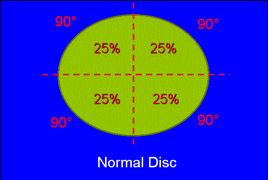
- Bulging discA disc in which the contour of the outer anulus extends, or appears to extend, in the horizontal (axial) plane beyond the edges of the disc space, over greater than 50% (180 degrees) of the circumference of the disc and usually less than 3mm beyond the edges of the vertebral body apophyses.
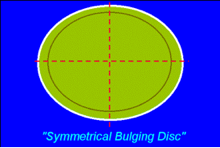
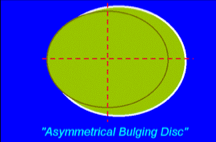
- Radial fissure or tear(B): Disruption of annular fibers extending from the nucleus outward toward the periphery of the annulus, usually in the vertical (cranio-caudal) plane, with occasional horizontal (transverse) components.
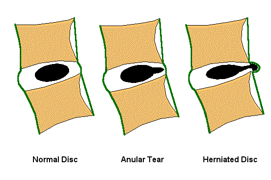
- ProtrusionProtrusion is a herniated disc in which the greatest distance, in any plane, between the edges of the disc material beyond the disc space is less than the distance between the edges of the base in the same plane. The test of protrusion is that there must be a localized (less than 50% or 180 degrees of the circumference of the disc.
Focal protrusion: Protrusion of disc material so that the base of the displaced material is less than 25% (90 degrees) of the circumference of the disc.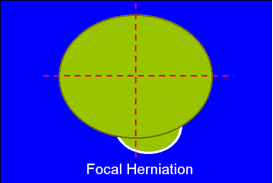
Broad-based protrusion: Herniation of disc material extending beyond the outer edges of the vertebral body apophyses over an area greater than 25% (90 degrees) and less than 50% (180 degrees) of the circumference of the disc.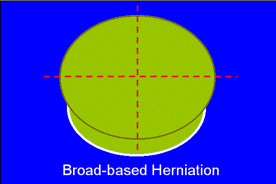
- ExtrutionA herniated disc in which, in at least one plane, any one distance between the edges of the disc material beyond the disc space is greater than the distance between the edges of the base in the same plane, or when no continuity exists between the disc material beyond the disc space and that within the disc space.
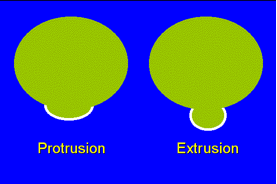
- Sequestration(C): An extruded disc in which a portion of the disc tissue is displaced beyond the outer annulus and maintains no connection by disc tissue with the disc of origin.
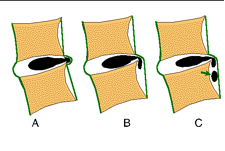
- ZonesAnterior zone: Peridiscal zone that is anterior to the mid-coronal plane of the vertebral body.
Central zone: Zone within the vertebral canal between sagittal planes through the medial edges of each facet.
Sub-articular zone: The zone, within the vertebral canal, sagittally between the plane of the medial edges of the pedicles and the plane of the medial edges of the facets, and coronally between the planes of the posterior surfaces of the vertebral bodies and the under anterior surfaces of the superior facets.
Foraminal zone: The zone between planes passing through the medial and lateral edges of the pedicles.
Extra-foraminal zone: The zone beyond the sagittal plane of the lateral edges of the pedicles, having no well-defined lateral border.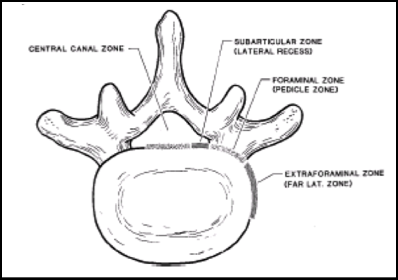
- LevelsDisc level: The level of the intervertebral disc.
Supra-pedicular level: The level within the vertebral canal between axial planes of the superior end-plate of the vertebra caudad to the disc space in question and the superior margin of the pedicle of that vertebra.
Pedicular level: The level between axial planes through the upper and lower edges of the pedicle.
Infra-pedicular level: The level between the axial planes of the inferior edge of the pedicle craniad to the disc in question and the inferior end-plate of the vertebral body above.
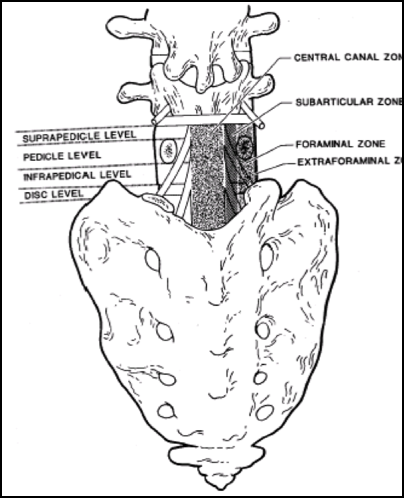
- Normal disc
-
The Dallas Discogram Description
A classification system for radial tears.
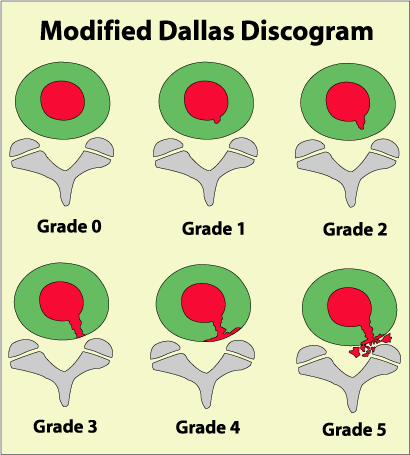
- General informationNot all radial annular tears are alike. Most radial tears only extend partially into the annulus and do not reach the pain sensitive out 1/3 of the annulus. Therefore it became important to develop a way to classify the severity of these radial tears. Enter the Dallas Discogram Description.
The ‘Modified Dallas Discogram Description’ was finalized in the 1990’s and is the Gold Standard for the classification of Radial annular tears. It was initially developed by a group of researcher from Texas (14) and then ‘modified’ by Bogduk et al (7), and finally Schellhas et al (15). In a nutshell, the nucleus of the suspected disc will be injected with a contrast material, that will out-line the nucleus and/or and leaking tears. After a short time, the patient is taken to the CT and axial images of the disc are made. If the nucleus is torn, the contrast will have migrated down the tear. The degree of disc disruption is described by how far the contrast migrates away from the center of the disc. - CategoriesThere are six possible categories that describe the severity of the radial annular tear.
- Grade 0 is a normal disc; where no contract material leaks from the nucleus.
- Grade 1 tear will leak contrast material only into the inner 1/3 of the annulus.
- Grade 2 tear will leak contrast through the inner 1/3 and into the middle 1/3 of the disc.
- Grade 3 tear will leak contrast through the inner and middle annulus. The contrast spills into the outer 1/3 of the annulus.
- Grade 4 tear further describes a grade 3 tear. Not only does the contrast extend into the outer 1/3 of the annulus, but it is seen spreading concentrically around the disc. To qualify as a grade 4 tear the concentric spread must be greater than 30 degrees. Pathologically, this represents the merging of a full thickness radial tear with a concentric annular tear.
- Grade 5 tear describes either a grade 3 or grade 4 radial tear that has completely ruptured that outer layers of the disc and is leaking contract material out of the disc which can cause a chemical radiculopathy in one or both of the extremities.
- General information

